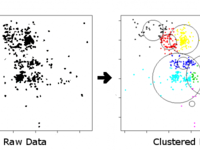Kmean Cluster是一种机器学习中常用的无监督分析方法,例如,在最近的项目中,要从数以百万、千万计的高维图像特征中提取具有代表性的视觉词,就用到了此类技术。
Kmean并不是一种高效的
算法,理论可以证明,在欧几里得空间中的Kmean问题是NP-Hard(即使聚类数仅为2)。假设单个向量维度为d,向量数为n,目标聚类数为k,则算法的时间复杂度=n^(dk+1)*logn。
kmean的示意图如下:

一些启发式的算法对Standard Kmean的效率进行了优化,常见的包括:
- 基于最大期望的算法(EM algorithm):采用概率的方式将输入向量分配到各个聚类当中(而非Standard Kmean中的绝对分配),并且采用高斯分布代替Standard Kmean中的算术平均值计算聚类中心。
- Kmean++:通过选取初始聚类集合来达到更好的效果
- filtering algorithm:通过使用kd树来加速Kmean效率
- 其它优化算法:诸如coresets、triangle inequ以及Escape local optima等算法
尽管如此,经典的Standard Kmean仍然是使用频率较高的聚类算法,在数据量不大或者demo阶段被广为使用,下面给出java实现的代码:
public Cluster[] cluster(final List<Clusterable> values, int numClusters) {
Cluster[] clusters = calculateInitialClusters(values, numClusters);
boolean recalculateClusters = true;
int numIterations = 0;
while (recalculateClusters) {
// add all items to nearest cluster
clusters = assignClusters(clusters, values);
// see if the cluster distance hasn't moved
recalculateClusters = mChecker.recalculateClusters(clusters);
// if it needs to be run again, set up new clusters on the updated
// centers
if (recalculateClusters) {
if (numIterations > mMaxReclustering) {
recalculateClusters = false;
}
clusters = getNewClusters(clusters);
numIterations++;
}
}
return clusters;
}
import java.util.ArrayList;
import java.util.List;
import java.util.Random;
public class KMeansClusterer extends AbstractKClusterer {
public KMeansClusterer() {
super();
}
protected Cluster[] assignClusters(Cluster[] clusters,final List<Clusterable> values){
assignClustersByDistance(clusters, values);
return clusters;
}
protected void assignClustersByDistance(Cluster[] clusters, List<Clusterable> values){
for ( int j = 0; j < values.size(); j++ ){
Clusterable val = values.get(j);
Cluster nearestCluster = null;
double minDistance = Float.MAX_VALUE;
for ( int i = 0; i < clusters.length; i++ ){
Cluster cluster = clusters[i];
double distance = ClusterUtils.getEuclideanDistance(val,cluster);
//System.out.println("cluster " + i + ", point " + j + ",distance: " + distance);
if ( distance < minDistance ){
nearestCluster = cluster;
minDistance = distance;
}
}
nearestCluster.addItem(val);
}
}
protected Cluster[] getNewClusters(Cluster[] clusters){
for ( int i = 0; i < clusters.length; i++ ){
if ( clusters[i].getItems().size() > 0 )
clusters[i] = new Cluster(clusters[i].getClusterMean(),i);
}
return clusters;
}
public static void main(String args[]){
Random random = new Random(System.currentTimeMillis());
int numPoints = 50;
List<Clusterable> points = new ArrayList<Clusterable>(numPoints);
for ( int i = 0; i < numPoints; i++ ){
int x = random.nextInt(1000) - 500;
int y = random.nextInt(1000) - 500;
points.add(new Point((float)x,(float)y));
}
KClusterer clusterer = new KMeansClusterer();
Cluster[] clusters = clusterer.cluster(points,10);
for ( Cluster c : clusters ){
System.out.println(c.getItems().size());
}
}
public static boolean hasBadValue(double[] values){
for ( double value : values ){
if ( !(value < 1 && value > -1) ){
System.out.println(value + " is 'bad'");
return true;
}
}
return false;
}
}
Standard Kmean在大数据量时其表现往往不尽如人意,后续我会附上kd random forest的优化算法

- 大小: 46.6 KB
